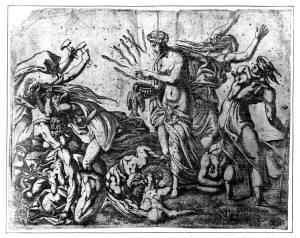Etching by Antonio Fantuzzi, 22.5 x 28.4 S (Oxford). Inscribed at the lower right with a monogram composed of joined letters: .ATF ..
Fig.E.79a (Oxford)
Fig.E.79b (London)
Fig.E.79c (London, monogram)
COLLECTIONS: London, 1874-8-8-465. Oxford (red ink, slightly torn in places).
LITERATURE:
Panofsky, 1958, 177, n. 118.
Zerner, 1969, A.F.22 (London).
Béguin, RdA, 1969, 105, and Fig. 11 (London).
Borea, 1980, 262, no. 668, 263, Fig. (London).
Carroll, 1987, 301, n. 2, under no. 95.
Brugerolles and Guillet, 1994, 37, under no. 14, the rays in Rosso’s drawing replaced by seven snakes.
This etching is based on Rosso’s drawing, in reverse, in Ensba in Paris (Fig.D.67a). In the print, the rays of energy have been eliminated and seven snakes have been added radiating from the area just above the box, a depiction that Béguin relates to a French tradition that here introduces into the scene a double representation of the vices. There are, however, eight figures in addition to Pandora, the eighth apparently personifying Tribulation. Béguin also indicates that the bird is a dove of peace rather than a crow as it was identified by the Panofskys.
As discussed in the catalogue entry of Rosso’s drawing (D.67), the old nude woman in the lower left corner of the print is clearly shown biting a snake, while in the drawing this figure, according to the Panofskys, is eating her own entrails and hence can be identified as Envy. But the object in question in the somewhat raggedly executed drawing could also be a snake. Furthermore, the Panofskys (1965, 36) identified the hunched over figure at the right of the drawing as Avarice clutching her “purse,” while in the print this figure is bearded and the money bags are transformed into a bundle, the real nature of which is not clear; the print also shows another arm here with the head of the figure resting in the palm of the hand. Furthermore, Fantuzzi has slightly changed Pandora’s headdress, shown her pointing toward a snake with her index finger, and provided the ground with grass, a few larger plants, and a rock. The horizon is seen at the right.
In spite of the differences that appear in the etching, it is still likely that Fantuzzi worked from Rosso’s drawing in Paris. The changes that have taken place can be accounted for first of all by the illegibleness of certain details of the rather loosely rendered drawing, and second, it would seem, by Fantuzzi’s wish to give clearer meaning to the image according to his knowledge of the subject and his reading of Rosso’s drawing. The addition of the seven snakes made certain that the vices were understood as coming out of the box. Avarice was turned into a lazy man, and Envy’s entrail became without question a snake. A real setting was supplied. The bird does seem to be a dove in the print, although this does not mean that it was intended as one in the drawing.
COPY?, DRAWING: An eighteenth century inventory of drawings in the Gonzaga Collection in the Villa di S. Michele near Novellara (Campori, 1870, 973) lists: Rosso fiorentino. Pandora, che porge il vaso dei mali all’aguila, con serpenti: disegno acguerellato, zecchini 2. The description recalls Fantuzzi’s etching. If the drawing is by Rosso and identical in its composition to the etching, then it would indicate that the changes seen there are due to Rosso. But the drawing could be a modified copy of Rosso’s drawing in Paris to serve as the model for Fantuzzi’s etching. The technique of the drawing suggests these possibilities. Then, again, it could be a copy of the print. However, it is also possible that the drawing is of an entirely different composition by Rosso, or by someone else entirely. But the title given that mentions the box being offered to an eagle would seem to indicate a relationship to Rosso’s known drawing and Fantuzzi’s etching.

